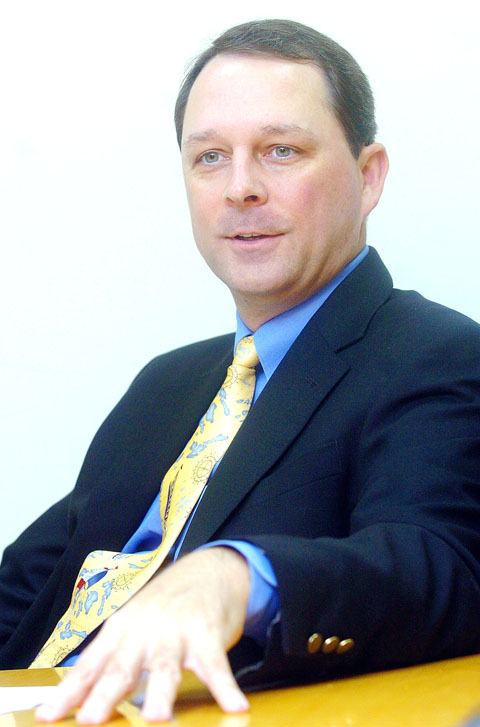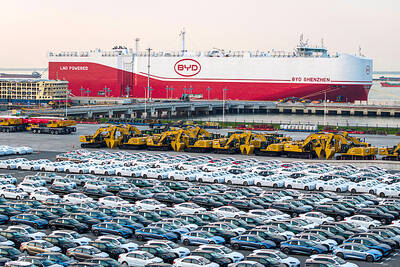Taipei Times (TT): Explain what a server is to the non-tech savvy readers out there.
Mark Wiltse: Servers help information to flow around the world. As more people get on the Internet, and more people communicate through Google and Yahoo, [these companies] need a lot of computer power. [These companies] have server farms, rolls and rolls of computers, multiples of them. As you surf on the Internet you want it to be pretty quick.

PHOTO: CHANG CHIA-MING, TAIPEI TIMES
TT: What are your goals and responsibilities as the director of Taiwan System and Technology Laboratory (TSTL)?
Wiltse: As director of the lab, and as the very visible face of IBM here in Taiwan from a development perspective, my job function mirrors more of a general manager’s role than a development director’s role.
[I am] general manager in the sense [that] I do have product delivery responsibility [and] external visibility responsibility. As a senior leader here interfacing to some of the other functions, I communicate regularly with other labs.
[For instance, there are many common building blocks among the labs]. If there’s a certain mechanical chassis between two or three product lines, we communicate frequently to make sure we’re all designing to the same mechanical chassis.
TT: What are your views on the research and development (R&D) environment in Taiwan? Can you contrast that to the environment in the US or in China?
Wiltse: There’s more similarity than differences from a worldwide perspective. Differences [lie only in] what technologies people have started to work on. Worldwide there are more similarities. Math is math. If you take that to an extreme, it’s engineering, it’s all the same. The logical thinking and the rigor is [all] the same.
TT: You mentioned previously that TSTL is “not merely a remake of the US experience.” Can you elaborate on that?
Wiltse: TSTL is not merely a remake of the US experience. We’re new; people have only been here [for] four years. Most of the labs in the US have been around for 30 to 35 years. They take on a certain mature personality; they have a lot of experts because we have been innovating for that long in those places.
First, TSTL is more of a partnership environment that our US colleagues, so that has generated an interesting development model. Secondly, being younger in general [makes a difference]— our average age [here] is a little bit younger. Thirdly, from a responsibility perspective, we are able to provide opportunities to people earlier in their careers. And, lastly, there’s a certain eagerness [at TSTL for engineers] to try things when you have fresh energy and fresh people.
TT: TSTL can be very discrete sometimes. Why is that?
Wiltse: We are secretive not to be evil, but because we are working on unannounced products. Many of those programs we are designing, we are trying to make better than our competitors. The more that I can keep hidden until I announce it, [the more] I can be in a better position.
TT: Who are your competitors? Do you look at each other’s products when designing your own?
Wiltse: Dell and HP are the big two for us. We watch them on multiple elements: cost, performance, design and ease of use. We do not copy them and they don’t copy us because each of these companies has a different focus from a customer perspective. We all have different personalities.
[At IBM] we offer innovation and high value to customers. This isn’t something our competitors are good at. They might be much better at low-cost design, for example. But that’s not what IBM is focused on. We’re trying to find the hard problems and solve them for our customers.
TT: Let’s talk a little about your collaboration with local companies.
Wiltse: Part of the reason we’re here is to partner up with the companies that are really experts at designing and developing the components for the computer. We’re excellent at system design. [With] the sub components [of our systems] throughout our history, we have allowed other companies to become the experts. And we began to utilize them.
So there are many companies here in Taiwan that we partner with in order to deliver products to our customers. Many of these are the same companies that Dell and HP partner with.
TT: How is TSTL helping local companies to transit from being original equipment manufacturers (OEM) to original design manufacturers (ODM)?
Wiltse: The evolution of local Taiwanese companies that we’re partnering with has been happening for over 15 years.
They started out being focused on manufacturing that expertise began to solidify, there were lower level design elements that became more efficient for them to do, rather than for us to do in the United States.
Over time, as Taiwanese company skills began to grow, we began to continue our education to try to move them to places higher up the skill set. That evolution has been happening and is expected to [continue] over the next 15 to 20 years.
These local companies began to change their thinking process of simply doing what they’re told to [do]. If I have my partners focused on innovation and contributing to invention, that expands the number of people making IBM products better and more innovative.
TT: What are IBM’s efforts toward green technology?
Wiltse: Saving energy has turned out to be something our customers are now demanding. If I can save 1, 2 or 3 watts a server, these [server farms save] real money. [Also] It goes beyond just computers because the less heat I put out, there’s more savings.
We have both won and lost based on power consumption. Although people like to talk about green, we’re pursuing green for a very basic business reason: Our customers are demanding it.
If we don’t pursue green, we’re not going to be competitive. So clearly, given our innovation and our expertise, that’s a key area [in which] we think we can be [a leader].
Today, if you look at the purchase price, the computer has been the smallest part of the expense of a computer. Operating cost, cooling cost, maintenance cost are significantly larger portions of total cost of ownership for computers.
TT: Due to the economic slowdown, are you witnessing diminished corporate spending on IT products?
Wiltse: It’s too early to tell. If you look at companies around the world that are well managed, they have long-term strategies. The best IBM customers, we have long-term relationships. I’m optimistic that our relationships are going to be maintained with our key customers. We’ll continue to talk to our customers and continue to develop the solution that they need.
TT: What are your thoughts on cloud computing?
Wiltse: It’s wonderful. If you take cloud computing as a concept, one of the building blocks of cloud computing is the iDataPlex. The concept of sharing IT resources without anyone being dedicated to one particular server. [This] really helps companies increase efficiency of computer usage. [Cloud computing means] to be able to use IT and infrastructure for multiple applications.
[If] you can extend that further where people can share, that [would] generate a little bit of nervousness if one company wants to share its IT resources with another company. We’re still working on that concept.
Parallel [cloud computing] with electricity. You don’t have a dedicated power plant. The electricity is just in the infrastructure. If computing power is part of the infrastructure, then it becomes more like a utility than anything else.
[In fact] computer technology is very, very evolutionary. Every once in a while we’ll come to a point where several technologies that have been evolving over a number of years come together in form. Now [as] there [is] some excitement, more people get in, more innovation applies, and [we are more] able to generate real solutions for customers.

GROWING OWINGS: While Luxembourg and China swapped the top three spots, the US continued to be the largest exposure for Taiwan for the 41st consecutive quarter The US remained the largest debtor nation to Taiwan’s banking sector for the 41st consecutive quarter at the end of September, after local banks’ exposure to the US market rose more than 2 percent from three months earlier, the central bank said. Exposure to the US increased to US$198.896 billion, up US$4.026 billion, or 2.07 percent, from US$194.87 billion in the previous quarter, data released by the central bank showed on Friday. Of the increase, about US$1.4 billion came from banks’ investments in securitized products and interbank loans in the US, while another US$2.6 billion stemmed from trust assets, including mutual funds,

Micron Memory Taiwan Co (台灣美光), a subsidiary of US memorychip maker Micron Technology Inc, has been granted a NT$4.7 billion (US$149.5 million) subsidy under the Ministry of Economic Affairs A+ Corporate Innovation and R&D Enhancement program, the ministry said yesterday. The US memorychip maker’s program aims to back the development of high-performance and high-bandwidth memory chips with a total budget of NT$11.75 billion, the ministry said. Aside from the government funding, Micron is to inject the remaining investment of NT$7.06 billion as the company applied to participate the government’s Global Innovation Partnership Program to deepen technology cooperation, a ministry official told the

Taiwan Semiconductor Manufacturing Co (TSMC, 台積電), the world’s leading advanced chipmaker, officially began volume production of its 2-nanometer chips in the fourth quarter of this year, according to a recent update on the company’s Web site. The low-key announcement confirms that TSMC, the go-to chipmaker for artificial intelligence (AI) hardware providers Nvidia Corp and iPhone maker Apple Inc, met its original roadmap for the next-generation technology. Production is currently centered at Fab 22 in Kaohsiung, utilizing the company’s first-generation nanosheet transistor technology. The new architecture achieves “full-node strides in performance and power consumption,” TSMC said. The company described the 2nm process as

POTENTIAL demand: Tesla’s chance of reclaiming its leadership in EVs seems uncertain, but breakthrough in full self-driving could help boost sales, an analyst said Chinese auto giant BYD Co (比亞迪) is poised to surpass Tesla Inc as the world’s biggest electric vehicle (EV) company in annual sales. The two groups are expected to soon publish their final figures for this year, and based on sales data so far this year, there is almost no chance the US company led by CEO Elon Musk would retain its leadership position. As of the end of last month, BYD, which also produces hybrid vehicles, had sold 2.07 million EVs. Tesla, for its part, had sold 1.22 million by the end of September. Tesla’s September figures included a one-time boost in